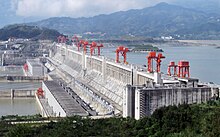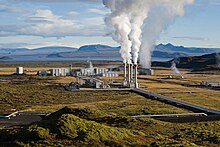
Back طاقة متجددة بنسبة 100% Arabic Energía renovable 100% Spanish Energia % 100 berriztagarri Basque 100% eneji emeghariri ọhụrụ IG 100% 재생 가능 에너지 Korean 100% energii odnawialnej Polish 100%-на відновлювана енергетика Ukrainian
| Part of a series on |
| Renewable energy |
|---|
 |








100% renewable energy is the goal of the use renewable resources for all energy. 100% renewable energy for electricity, heating, cooling and transport is motivated by climate change, pollution and other environmental issues, as well as economic and energy security concerns. Shifting the total global primary energy supply to renewable sources requires a transition of the energy system, since most of today's energy is derived from non-renewable fossil fuels.
Research into this topic is fairly new, with very few studies published before 2009, but has gained increasing attention in recent years. The majority of studies show that a global transition to 100% renewable energy across all sectors – power, heat, transport and industry – is feasible and economically viable.[6][7][8][9][need quotation to verify] A cross-sectoral, holistic approach is seen as an important feature of 100% renewable energy systems and is based on the assumption "that the best solutions can be found only if one focuses on the synergies between the sectors" of the energy system such as electricity, heat, transport or industry.[10]
The main barriers to the widespread implementation of large-scale renewable energy and low-carbon energy strategies are seen to be primarily social and political rather than technological or economic.[11] The key roadblocks are: climate change denial, the fossil fuels lobby, political inaction, unsustainable energy consumption, outdated energy infrastructure, and financial constraints.[12]
- ^ "Share of electricity production from renewables". Our World in Data. Retrieved 15 August 2023.
- ^ Wright, Matthew; Hearps, Patrick; et al. Australian Sustainable Energy: Zero Carbon Australia Stationary Energy Plan Archived 24 November 2015 at the Wayback Machine, Energy Research Institute, University of Melbourne, October 2010, p. 33. Retrieved from BeyondZeroEmissions.org website.
- ^ Innovation in Concentrating Thermal Solar Power (CSP), RenewableEnergyFocus.com website.
- ^ Stern, Ray (10 October 2013). "Solana: 10 Facts You Didn't Know About the Concentrated Solar Power Plant Near Gila Bend". Phoenix New Times.
- ^ Statistical Review of World Energy, Workbook (xlsx), London, 2016
- ^ Bogdanov, Dmitrii; Gulagi, Ashish; Fasihi, Mahdi; Breyer, Christian (1 February 2021). "Full energy sector transition towards 100% renewable energy supply: Integrating power, heat, transport and industry sectors including desalination". Applied Energy. 283: 116273. Bibcode:2021ApEn..28316273B. doi:10.1016/j.apenergy.2020.116273. ISSN 0306-2619.
- ^ Teske, Sven, ed. (2019). Achieving the Paris Climate Agreement Goals. doi:10.1007/978-3-030-05843-2. ISBN 978-3-030-05842-5. S2CID 198078901.
- ^ Cite error: The named reference
:6was invoked but never defined (see the help page). - ^ Cite error: The named reference
:7was invoked but never defined (see the help page). - ^ Hansen, Kenneth; et al. (2019). "Status and perspectives on 100% renewable energy systems". Energy. 175: 471–480. Bibcode:2019Ene...175..471H. doi:10.1016/j.energy.2019.03.092.
The great majority of all publications highlights the technical feasibility and economic viability of 100% RE systems.
- ^ Koumoundouros, Tessa (27 December 2019). "Stanford Researchers Have an Exciting Plan to Tackle The Climate Emergency Worldwide". ScienceAlert. Retrieved 5 January 2020.
- ^ Wiseman, John; et al. (April 2013). "Post Carbon Pathways" (PDF). University of Melbourne.
© MMXXIII Rich X Search. We shall prevail. All rights reserved. Rich X Search